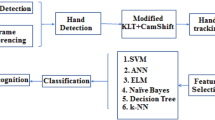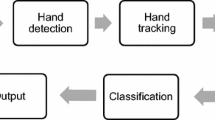Abstract
Detection of bare-hand under non-ideal conditions is a challenging task. Most of the existing hand detection systems are developed under limited environmental constraints. In this study, a robust two-level bare-hand detector is integrated with a 58 keyboard characters recognition model. At first, the Gaussian mixture model (GMM) based foreground detector is used to segment the region of interest (ROI), which is further classified using Color-texture and texture based models to detect the actual fist. The detected hand is tracked using modified Kanade–Lucas–Tomasi (KLT) tracker to generate the required trajectory points of the character. The feature space for character recognition consists of existing features and three new features, namely, Local Geometrical Area Ratio (LGAR), Area of two halves (ATH), Curve-Area feature (CAF) that are extracted from the trajectory points. Feature space is optimized using statistical analysis algorithms. Multi-factor analysis of individual character subsets such as alphabets, numbers, ASCII characters, etc., are carried out using multiple conventional classifiers along with Support vector machine (SVM), extreme learning machine (ELM), artificial neural network (ANN), and proposed Neuro-fuzzy classifiers. The proposed GMM based motion detection method achieves an accuracy of 100% during the segmentation of ROI, followed by an increase of 46.77% in the accuracy of two-level hand detection under non-ideal conditions. Maximum accuracy of 58 character system using proposed features and ANN classifier is observed to be 92.56%.
















Similar content being viewed by others
References
Barros P, Maciel-Junior NT, Fernandes BJ, BezerraBL FSM (2017) A dynamic gesture recognition and prediction system using the convexity approach. Comput Vis Image Underst 155:139–149
Bengio S, Bourlard H (2005) Machine learning for multimodal interaction. Springer, Berlin, Heidelberg
Bhuyan MK, Kumar DA, MacDorman KF, Iwahori Y (2014) A novel set of features for continuous hand gesture recognition. Journal on Multimodal User Interfaces 8(4):333–343
Bianconi F, Harvey RW, Southam P, Fernández A (2011) Theoretical and experimental comparison of different approaches for color texture classification. J Electron Imaging 20(4):043006
Cetisli B (2010) Development of an adaptive neuro-fuzzy classifier using linguistic hedges: Part 1. Expert Syst Appl 37(8):6093–6101
Cetisli B (2010) The effect of linguistic hedges on feature selection: Part 2. Expert Syst Appl 37(8):6102–6108
Cetişli B, Barkana A (2010) Speeding up the scaled conjugate gradient algorithm and its application in neuro-fuzzy classifier training. Soft Comput 14(4):365
Chen Q, Georganas ND, and Petriu EM (2007) Real-time vision-based hand gesture recognition using haar-like features. In Instrumentation and Measurement Technology Conference Proceedings, 2007. IMTC 2007, IEEE. pp. 1–6
Dalal N, Triggs B (2005) Histograms of oriented gradients for human detection. In Computer Vision and Pattern Recognition. IEEE Computer Society Conference 1:886–893
Ding H, Feng PM, ChenW LH (2014) Identification of bacteriophage virion proteins by the ANOVA feature selection and analysis. Mol BioSyst 10(8):2229–2235
Douglas DH, and Peucker TK (2011) Algorithms for the Reduction of the Number of Points Required to Represent a Digitized Line or its Caricature. Classics in Cartography: Reflections on Influential Articles from Cartographica, Wiley Online Library, pp. 15–28
Dürre J, Paradzik D, Blume H (2018) A HOG-based Real-time and Multi-scale Pedestrian Detector Demonstration System on FPGA. In Proceedings of the 2018 ACM/SIGDA International Symposium on Field-Programmable Gate Arrays, pp. 163–172
Elmezain M, Al-Hamadi A, Krell G, El-Etriby S, and Michaelis B (2007) Gesture recognition for alphabets from hand motion trajectory using hidden markov models. In 2007 IEEE international symposium on signal processing and information technology IEEE, pp. 1192–1197
Friedman J, Hastie T, Tibshirani R (2000) Additive logistic regression: a statistical view of boosting (with discussion and a rejoinder by the authors). Ann Stat 28(2):337–407
Haria A, Subramanian A, Asokkumar N, Poddar S, Nayak JS (2017) Hand gesture recognition for human computer interaction. Proc Comput Sci 115:367–374
Jian M, Lam KM (2014) Face-image retrieval based on singular values and potential-field representation. Signal Process 100:9–15
Jian M, Lam KM (2015) Simultaneous hallucination and recognition of low-resolution faces based on singular value decomposition. IEEE Trans Circuits Syst Video Technol 25(11):1761–1772
Jian M, Lam KM, Dong J, Shen L (2014) Visual-patch-attention-aware saliency detection. IEEE trans cybern 45(8):1575–1586
Jian M, Qi Q, Dong J, Sun X, Sun Y, Lam KM (2018) Saliency detection using quaternionic distance based weber local descriptor and level priors. Multimed Tools Appl 77(11):14343–14360
Jian M, Zhang W, Yu H, Cui C, Nie X, Zhang H, Yin Y (2018) Saliency detection based on directional patches extraction and principal local color contrast. J Vis Commun Image Represent 57:1–11
KaewTraKulPong P, Bowden R (2002) An improved adaptive background mixture model for real-time tracking with shadow detection. In Video-based surveillance systems, Springer, pp. 135–144
Kakumanu P, Makrogiannis S, Bourbakis N (2007) A survey of skin-color modeling and detection methods. Pattern Recogn, Elsevier 40(3):1106–1122
Kao CY, Fahn CS (2011) A human-machine interaction technique: hand gesture recognition based on hidden Markov models with trajectory of hand motion. Process Eng 15:3739–3743
Karam M (2006) A framework for research and design of gesture-based human computer interactions. PhD Thesis, University of Southampton
Kittler J, Hatef M, Duin RPW, Matas J (1998) On combining classifiers. IEEE Trans Pattern Anal Mach Intell 20:226–239
Kobayashi T, Otsu N (2008) Image feature extraction using gradient local auto-correlations. In: European conference on computer vision. Springer, Berlin, Heidelberg, pp 346–358
Kodituwakku SR, Selvarajah S (2004) Comparison of color features for image retrieval. Indian J Comput Sci Eng 1(3):207–211
Kuncheva LI (2002) A theoretical study on six classifier fusion strategies. IEEE Trans Pattern Anal Mach Intell 24(2):281–286
Lepistö L, Kunttu I, Visa A (2005) Color-based classification of natural rock images using classifier combinations. Lect Notes Comput Sci 3540:901–909
Li C, Xie C, Zhang B, Chen C, Han J (2018) Deep Fisher discriminant learning for mobile hand gesture recognition. Pattern Recogn 77:276–288
Lin J, Ding Y (2013) A temporal hand gesture recognition system based on hog and motion trajectory. Optik 124(24):6795–6798
Liu Y, Wang X, Yan K (2018) Hand gesture recognition based on concentric circular scan lines and weighted K-nearest neighbor algorithm. Multimed Tools Appl 77(1):209–223
Lv Z, Halawani A, Feng S, Ur Réhman S, Li H (2015) Touch-less interactive augmented reality game on vision-based wearable device. Pers Ubiquit Comput 19(3–4):551–567
McCue R (2009) A Comparison of the Accuracy of Support Vector Machine and Naıve Bayes Algorithms. In Spam Classification
Misra S, Laskar RH (2017) Multi-factor analysis of texture and color-texture features for robust hand detection in non-ideal conditions. In Region 10 Conference, TENCON 2017–2017 IEEE, pp. 1165–1170
Misra A, Abe T, Deguchi K (2011) Hand Gesture Recognition Using Histogram of Oriented Gradients and Partial Least Squares Regression. In MVA, pp. 479–482
Misra S, Singha J, Laskar RH (2017) Vision-based hand gesture recognition of alphabets, numbers, arithmetic operators and ASCII characters in order to develop a virtual text-entry interface system. Neural Computing and Applications, Springer, pp. 1–19
Pietik¨ainen M, Nieminen S, Marszalec E, and Ojala T (1996) Accurate color discrimination with classification based on features distributions, In Proceedings of the 13th International Conference on Pattern Recognition, 3, :833–838
Rautaray SS, Agrawal A (2015) Vision based hand gesture recognition for human computer interaction: a survey. Artif Intell Rev 43(1):1–54
Rekha J, Bhattacharya J, Majumder S (2011) Hand gesture recognition for sign language: A new hybrid approach In Proc. Int. Conf. Image Processing, Computer Vision, and Pattern Recognition, pp. 80–86
Schapire RE (1990) The strength of weak learnability. Mach learn, Springer 5(2):197–227
Schapire RE, Singer Y (1998) Improved boosting algorithms using confidence-rated predictions. In Proceedings of the eleventh annual conference on Computational learning theory, ACM, pp. 80–91
Singh C, Walia E, and Kaur KP (2017) Color Texture Description with Novel Local Binary Patterns for Effective Image Retrieval. Pattern Recognition
Singha J, Laskar RH (2016) Recognition of global hand gestures using self co-articulation information and classifier fusion. Journal on Multimodal User Interfaces 10(1):77–93
Singha J, Roy A, and Laskar RH (2015) Dynamic hand gesture recognition using vision-based approach for human–computer interaction. Neural Computing and Applications, Springer. pp. 1–3
Stančić I, Musić J, Grujić T (2017) Gesture recognition system for real-time mobile robot control based on inertial sensors and motion strings. Eng Appl Artif Intell 66:33–48
Stauffer C, Grimson WEL (1999) Adaptive background mixture models for real-time tracking. In: Computer Vision and Pattern Recognition, 1999. IEEE Computer Society Conference on, vol 2, pp 246–252
Sun CT, Jang JS (1993) A neuro-fuzzy classifier and its applications. In Fuzzy Systems, Second IEEE International Conference, pp. 94–98
Swain MJ, Ballard DH (1991) Color indexing. Int J Comput Vis 7(1):11–32
Tripathy DP, Reddy KGR (2017) Novel Methods for Separation of Gangue from Limestone and Coal using Multispectral and Joint Color-Texture Features. Journal of the Institution of Engineers (India): Series D 98(1):109–117
Vezhnevets A, Vezhnevets V (2005) Modest AdaBoost-teaching AdaBoost to generalize better. In Graphicon. 12(5):987–997
Wood JM (2007) Understanding and Computing Cohen’s Kappa: A Tutorial. WebPsychEmpiricist. Web Journal at http://wpe. info/. Accessed October 3, 2007
Woods RE, Gonzalez RC (1981) Real-time digital image enhancement. Proc IEEE 69(5):643–654
Xu Y, Gu J, Tao Z, Wu D (2009) Bare hand gesture recognition with a single color camera. In Image and Signal Processing, 2009. CISP'09. 2nd International Congress on IEEE, pp. 1–4
Xu D, Wu X, Chen YL, Xu Y (2014) Online dynamic gesture recognition for human robot interaction. J Intell Rob System 77(3–4):583–596
Yang C, Han DK, Ko H (2017) Continuous hand gesture recognition based on trajectory shape information. Pattern Recogn Lett 99:39–47
Yoon HS, Soh J, Bae YJ, Yang HS (2001) Hand gesture recognition using combined features of location, angle and velocity. Pattern Recogn 34(7):1491–1501
Zaki MM, Shaheen SI (2011) Sign language recognition using a combination of new vision based features. Pattern Recogn Lett 32(4):572–577
Zeng W, Wang C, and Wang Q (2018) Hand gesture recognition using Leap Motion via deterministic learning. Multimedia Tools and Applications, 1–22
Acknowledgments
Authors are thankful to Science & Engineering Research Board (SERB) under Department of Science & Technology (DST), Government of India for the financial support under IMPRINT-II project with Diary No. SERB/F/I0220/2018-2019. Authors are thankful to MEITY, Government of India for the financial support under the Visvesvaraya Ph.D. scheme with Grant no. PhD-MLA/4(74)/2015-16. The authors are also thankful to NIT Silchar and Aditya Engineering College, Surampelam, India for proving the authors with equipments for carrying out the research work.
Author information
Authors and Affiliations
Corresponding author
Ethics declarations
Conflict of interest
None.
Additional information
Publisher’s note
Springer Nature remains neutral with regard to jurisdictional claims in published maps and institutional affiliations.
Rights and permissions
About this article
Cite this article
Misra, S., Laskar, R.H. Integrated features and GMM Based Hand Detector Applied to Character Recognition System under Practical Conditions. Multimed Tools Appl 78, 34927–34961 (2019). https://doi.org/10.1007/s11042-019-08105-y
Received:
Revised:
Accepted:
Published:
Issue Date:
DOI: https://doi.org/10.1007/s11042-019-08105-y




